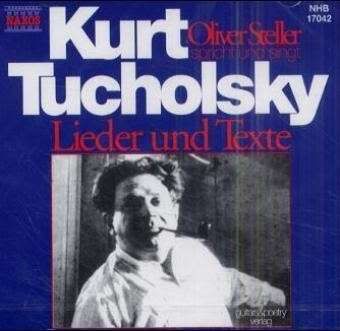
Kurt Tucholsky was born in his Jewish family's comfortable apartment in the Moabit district of Berlin (Lübecker Straße 13) on January 9, 1890. His father, Alexander Tucholsky, was an accountant at Berlin's Handelsgesellschaft bank. By the time little Kurt was two, the Tucholskys had moved to more prosperous living quarters in Berlin, but shortly thereafter, in 1893, the family moved to the Baltic port city of Stettin in Pommerania, where Kurt's father had been promoted by his bank. Many of Kurt's childhood memories were of this coastal north German landscape and the Plattdeutsch dialect he heard around him. (His father's family was from Greifswald, another northern port town.) While in Stettin, young Kurt began his first attempts at writing poetry. But in 1899, the ever-expanding Handelsgesellschaft bank moved Kurt's father back to Berlin as a bank director. Kurt attended Berlin's respected Französisches Gymnasium, the French secondary school founded by French Huguenots in 1689, where he was an average student. In 1903 he transferred to the Königliches Wilhelms-Gymnasium, where he ended his secondary education without standing out in any way. He later termed his school years in Berlin as “verlorene Jahre” (lost years).
In 1905 Kurt's father died and he lived for a time with his mother Doris until moving out to be on his own. In 1909, inspired by his uncle Max, an attorney, Kurt began law studies in Berlin. In 1910 he spent a summer semester studying in Geneva (his French was quite good). But even during his university studies, young Tucholsky was also getting his critical and satiric works published. By the time he graduated with a law degree (with some difficulty, in Jena in 1915), he was a published writer under various pseudonyms (Kurt, KT, Ignaz), a custom he would continue - later as “Peter Panter,” “Theobald Tiger,” “Ignaz Wrobel,” and “Kaspar Hauser.” But World War I had broken out and Tucholsky soon found himself in the Prussian army and on the war front.
With the war's end in 1918, Tucholsky became the chief editor of Ulk, a satiric magazine in Berlin, for which he had written anonymously as far back as 1907. In 1920 he married the physician Else Weil (the fictional Claire in Tucholsky's Rheinsberg novel). That same year he joined the USPD (Independent Socialist Party of Germany) and was also active in various anti-war activities. Beginning in 1924, Tucholsky was living in Paris as a correspondent for the Weltbühne and Vossische Zeitung, writing under his various pen names. He divorced Else Weil and married Mary Gerold, whom he had first met during the war. In 1926 he became the editor of the Weltbühne and changed it from a magazine for theatrical criticism into a voice for leftist intellectuals.
In 1929, the same year his Deutschland, Deutschland über alles was published, Tucholsky left Germany for Hindas, Sweden (near Gripsholm, the title of his 1931 novel). Beginning in 1932, he spent 14 months in Zurich, Switzerland, where he lived with his close friend Hedwig Müller (nicknamed "Nuuna"), a physician. While in Zurich, Tucholsky received news of the arrests of some of his friends and accquaintances in Germany. The Gestapo also ransacked his wife's apartment in Berlin. In 1933, by mutual agreement for Mary's protection, Tucholsky divorced his wife. That same year he had his books burned in Berlin and he lost access to his German book royalties. The Nazis also revoked Tucholsky's German citizenship (and that of 32 other artists and writers, including Heinrich Mann). In October 1933 Tucholsky returned to exile in Sweden, where he lived isolated for the most part from any local contact, with the exception of occasional visits by friends from France or Switzerland. He had become close friends with the Swedish Gertrude Meyer, and she accompanied him on his visits to the seashore that seemed to help his nose problems a little.
For years, Tucholsky had been suffering from illness and problems with his sense of smell and taste. Several operations had done little to help his condition. The news from Germany hardly helped his state of depression. On December 21, 1935, on one of her regular visits, Gertrude found Tucholsky unconscious on the floor. He died that night in the hospital in Göteborg, according to official records as the result of an overdose of Veronal. Some people then and now have questioned whether the death was really a suicide or not, but there is no real proof either way. Kurt Tucholsky's ashes were laid to rest in Sweden under an oak tree in the Mariefred cemetery he had described in his 1931 novel Schloß Gripsholm.
Here is a collection of songs and poems by Kurt Tucholsky, read and sung by Oliver Steller.
Kurt Tucholsky - Lieder und Texte
(192 kbps, 86 MB)
 "Tales of Tsotsi Beat" is a solid compilation of modern urban South Africa. The music of the townships has long embraced American and European pop and dance/club styles. Over 14 cuts, the Sheer Sund label literally gets down to it.
"Tales of Tsotsi Beat" is a solid compilation of modern urban South Africa. The music of the townships has long embraced American and European pop and dance/club styles. Over 14 cuts, the Sheer Sund label literally gets down to it. 

















